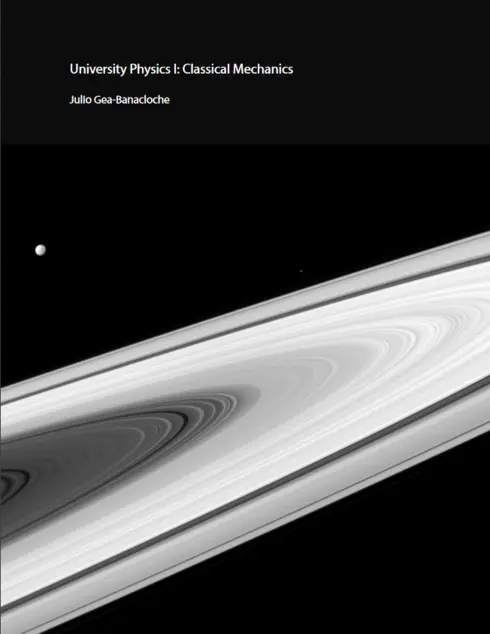
University Physics I: Classical Mechanics
![]()
![]()
![]()
![]()
![]()
Julio Gea-Banacloche, University of Arkansas
Copyright Year:
Publisher: University of Arkansas
Language: English
Formats Available
Conditions of Use
![]() Attribution-NonCommercial
Attribution-NonCommercial
CC BY-NC
Reviews
Reviewed by Mitchell Stephenson, Assistant Professor, University of Montana - Western on 1/29/20
Gea-Banacloche's text reviews the classic topics of physics (linear and angular kinetics and kinematics) in a linear manner before delving more deeply into more advanced topics of waves and thermodynamics. This is a great opportunity to prepare... read more
![]()
![]()
![]()
![]()
![]()
Reviewed by Mitchell Stephenson, Assistant Professor, University of Montana - Western on 1/29/20
Comprehensiveness
Gea-Banacloche's text reviews the classic topics of physics (linear and angular kinetics and kinematics) in a linear manner before delving more deeply into more advanced topics of waves and thermodynamics. This is a great opportunity to prepare students for the basics of Physics II by integrating the latter topics into the context of the former. Importantly, the author briefs the students on a suggested approach to the text, guiding them through a valuable study strategy that relies on the exercises and practice problems contained within.
Content Accuracy
I feel that it would be difficult for a physics textbook to be biased or error-filled unless the author was unable to use their own calculator! This text is well-designed, accurate, and uses realistic examples. Importantly, the simplified descriptions of phenomena and effects are more than adequate without being wordy.
Relevance/Longevity
Classic topics and examples in physics have changed little over the past decades, but this text does manage to stay relatively modern with clean, well-justified examples and problems. I would suggest that many of the examples could be expanded and related to physics students can observe and experience without substantial equipment or resources. Notably, biomechanics textbooks contextualize these phenomena to the human body, providing more relatable material examples to students.
Clarity
If there was a single strongest value of this text, it's clarity is certainly a prime contender. Too often, physics textbooks are mired in clauses and details that distract from the problem at hand. This text not only circumvents this risk, but also writes in an approachable, yet professional demeanor that communicates directly to the student. Other authors should take note at how the first person, directive narrative simplifies sentence structure and eases the transition into equations.
Consistency
Formatting, referencing, topical depth, and voice are all reliable throughout the text. I find this particularly impressive given the active narrative the author relies upon throughout.
Modularity
The Chapter/section/subsection organization often found in engineering publications author in Latex lends itself well to the text's modularity without excessively subdividing topics into too small elements. The presentation of the topics are interlaced, but not in a way that requires frequent navigation. This text also excels at it's modular value; I can envision portions of this text being used for multiple topics and courses in applied physics courses without undermining its educational and reference value.
Organization/Structure/Flow
The organization of this text surprised me slightly; it was not the organization I would have defaulted to, yet its narrative is beautifully constructed and cuts a linear logical path through multiple topics. The author does a wonderful job linking sections and chapters together, providing transitions helpful for student understanding without undermining the modularity of the text.
Interface
The text is adequately hyperlinked and consistently structured. The Latex-like formatting is sometimes wasteful, but does organize sections and subsections consistently. Figures are generally clear, although some do suffer from slight aliasing. It would be helpful to link to other sections in their references, and provide a "return to index" link at the end of sections for easier navigation when using the text modularly. I do find the in-text web addresses a bit cumbersome, and wonder if an embedded hyperlink would be preferable if combined with referenced web addresses included at the end of the chapter for those who print the text.
Grammatical Errors
This text is cleanly and clearly written with no grammatical or reference errors in the text or equations (the latter is a relatively rare commodity in the available physics OER, sadly).
Cultural Relevance
Examples are free of any cultural considerations, although I could argue that the bias towards contrived physics examples may alienate some biologically-interested students. Some examples are invaluably contextualized to biomechanics, but I feel that the more challenging the mathematical example, the more likely the author falls back on to cliche examples outside of the reach of human experience.
CommentsOverall, this is a wonderful text that is valuable in multiple contexts. I hope the author considers expanding their corpus of OER!
Table of Contents
- 1 Reference frames, displacement, and velocity
- 2 Acceleration
- 3 Momentum and Inertia
- 4 Kinetic Energy
- 5 Interactions and energy
- 6 Interactions, part 2: Forces
- 7 Impulse, Work and Power
- 8 Motion in two dimensions
- 9 Rotational dynamics
- 10 Gravity
- 11 Simple harmonic motion
- 12 Waves in one dimension
- 13 Thermodynamics
About the Book
This is a “minimalist” textbook for a first semester of university, calculus-based physics, covering classical mechanics (including one chapter on mechanical waves, but excluding fluids), plus a brief introduction to thermodynamics. The presentation owes much to Mazur’s The Principles and Practice of Physics: conservation laws, momentum and energy, are introduced before forces, and one-dimensional setups are thoroughly explored before two-dimensional systems are considered. It contains both problems and worked-out examples.
About the Contributors
Author
Julio Gea-Banacloche, University of Arkansas, Fayetteville
